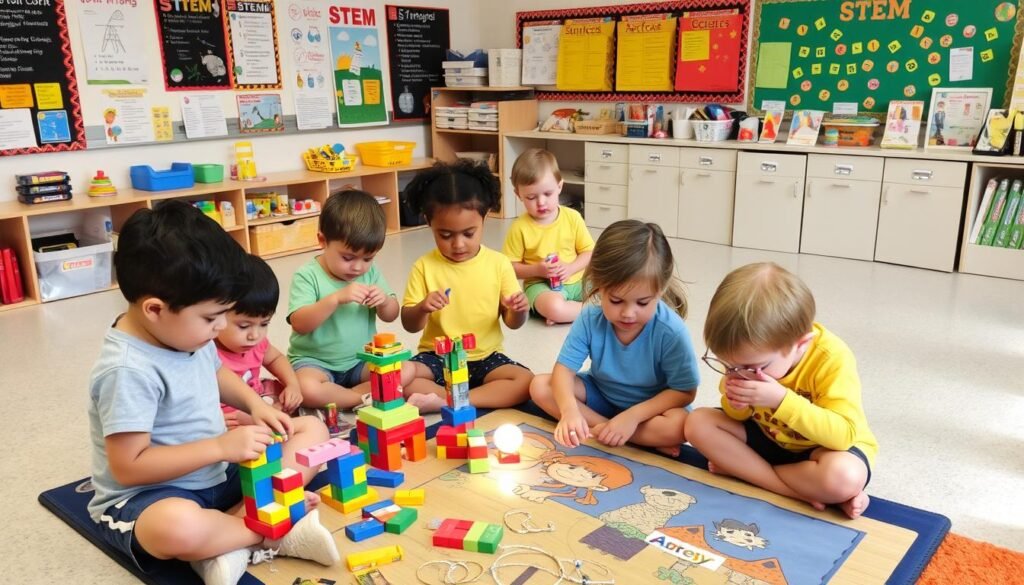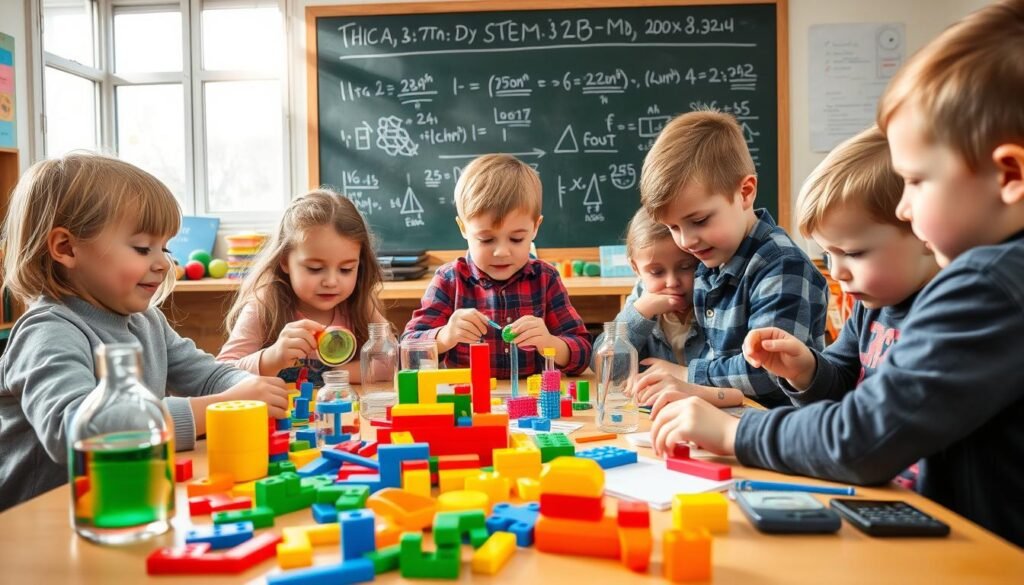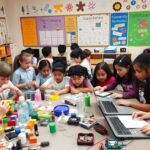STEM (Science, Technology, Engineering, and Mathematics) education is now more important than ever for young kids. Our world is changing fast, and kids need to be ready. STEM education helps them succeed in school and in jobs that use technology.
It makes kids think differently, sparking their curiosity and encouraging them to solve problems. This is especially true when kids are young, from infancy to third grade. At this age, their minds are open to learning new things.
Studies show that STEM education boosts reading, language skills, and thinking abilities. You don’t need a lot of money to teach STEM. Simple activities like building with blocks, gardening, and solving puzzles can help. This makes STEM learning easy for teachers and parents to do at home.
Key Takeaways
- STEM education in early childhood lays the foundation for future academic and professional success.
- Implementing STEM concepts through play-based learning promotes cognitive development and critical thinking skills.
- STEM education can be integrated into everyday activities, making it a versatile and accessible approach for educators and families.
- Investing in early STEM learning helps prepare children for the growing demand for technology-focused jobs.
- STEM education has been linked to improvements in literacy, language learning, and executive functioning.
Understanding STEM Education Fundamentals
STEM education includes science, technology, engineering, and mathematics. It’s becoming more popular in early learning. But, it’s not just about using digital tools. It’s about making these subjects a part of everyday life and hands-on activities.
Defining STEM in Early Childhood Context
In early childhood, STEM education sparks curiosity. It helps kids explore their surroundings. They learn simple science, basic engineering, and technology.
Core Components of Early STEM Learning
- Hands-on exploration and experimentation
- Problem-solving and critical thinking
- Integrated learning across subject areas
- Emphasis on process rather than just outcomes
The Role of Play-Based Learning in STEM
Play is key in early STEM education. Activities like building blocks and water play help kids learn STEM naturally. They get to explore and understand the world better.
This method lets kids lead their learning. They form theories, ask questions, and participate fully.
The Learning Experience® focuses on STEM through play. They make sure kids get to explore and learn. This helps them develop problem-solving and critical thinking skills.
Early Cognitive Development Through STEM Activities

Starting kids in STEM (Science, Technology, Engineering, and Mathematics) early can change their minds a lot. These activities help them think, observe, and solve problems. It’s key for their young brains.
STEM activities make kids think, try, see, and think again about what they find. This helps them think better and solve problems. They can learn STEM in daily life, like playing outside or looking at things in the store.
- A UK study found early STEM education boosts kids’ thinking and problem-solving. Kids who did STEM showed better skills and thinking.
- Studies say STEM activities in early years grow brain paths for thinking and solving space problems.
- Research shows STEM early on can help girls feel more confident in STEM fields. It sparks their interest.
Also, STEM early on improves math skills. This helps kids do well in math and STEM subjects later on. It gives them a strong start for STEM careers.
“STEM activities help foster critical thinking, problem-solving, creativity, and curiosity in children. STEM learning equips children with the knowledge and tools to understand and address complex challenges.”
Adding STEM to early learning opens up kids’ potential. It helps grow their thinking skills. This prepares them for the challenges of today and tomorrow.
Building Critical Thinking and Problem-Solving Skills

STEM education is key in teaching young learners to think critically and solve problems. Kids learn through hands-on activities and open-ended questions. They develop their analytical skills by observing, analyzing, and forming theories.
STEM education sparks curiosity and a desire to understand the world. It encourages kids to explore and experiment. This helps them see how things work.
Developing Analytical Reasoning
STEM projects often involve teamwork. This promotes collaboration and critical thinking. Kids learn to work together and see things from different perspectives.
STEM activities teach kids to keep trying and improve their ideas. Pattern recognition and analysis are important in STEM. They help kids spot trends, make conclusions, and make informed decisions.
Fostering Scientific Inquiry
Exploration and experimentation are central to STEM education. They fuel kids’ curiosity and drive to understand the world. By doing hands-on activities and solving problems, kids learn to think scientifically.
They start to form hypotheses, test them, and draw conclusions. This way, they develop a scientific mindset.
Enhancing Creative Problem-Solving
STEM education boosts creative problem-solving skills. It encourages kids to design, build, and innovate. Through real-world applications and teamwork, kids apply their knowledge to solve complex problems.
This approach not only sharpens their critical thinking but also prepares them for the 21st-century workforce.
“Encouraging persistence in STEM education helps children develop critical thinking skills by teaching them to overcome challenges and refine their ideas.”
STEM Education Impact on Academic Success

Early STEM education is a key factor in future academic success. A study found that STEM education has a big impact on students’ grades. The biggest effect was seen in science.
The study looked at 64 research findings from 56 studies between 2014 and 2021. It also found that national studies showed the biggest impact. This shows how important STEM education is for students’ success.
STEM education boosts academic achievement and helps build early math skills needed for future success. Hands-on STEM learning makes students more interested in these subjects. It helps them understand the material better.
“STEM education significantly influenced students’ academic journey, igniting their passion for STEM fields, encouraging diligent study habits, facilitating entry into reputable colleges, and assisting in obtaining a quality education.”
But, there are challenges in connecting preschool STEM programs to K-12 curriculums. This can leave some children behind or make them repeat material during important learning times. It’s important to address these gaps to ensure everyone has access to STEM education and its benefits.
Preparing Children for Future Career Opportunities
STEM education is key for kids to get ready for the changing job market. The U.S. Bureau of Labor Statistics says STEM jobs will grow by 10.8% from 2018 to 2032. This is much faster than non-STEM jobs, showing a big need for people with tech and problem-solving skills.
Technology Literacy Development
Early STEM education helps kids learn to use technology well. As tech changes work, knowing digital tools is important. Coding, robotics, and other STEM activities help kids get ahead in a tech world.
Engineering and Mathematical Foundations
Learning engineering and math basics is crucial for many STEM careers. STEM education in early years helps kids understand complex problems and think creatively. These skills are important in fields like aerospace, biomedical engineering, and computer science.
21st Century Skills Development
STEM education also builds important 21st-century skills like teamwork, communication, and creativity. These “4 C” skills are what employers want. They help people work well in teams and come up with new ideas. By starting early, STEM education sets kids up for success in a fast-changing world.
Also Read : Top 10 Homeschooling Resources to Empower Your Teaching Journey
FAQs
Q: What is the importance of STEM education in early childhood learning?
A: The importance of STEM education in early childhood learning lies in its ability to provide students with foundational skills in science, technology, engineering, and mathematics. This framework fosters critical thinking, problem-solving, and innovative skills that are essential for success in the current and future workforce.
Q: How does STEM education support teaching and learning in early childhood?
A: STEM education supports teaching and learning by integrating hands-on, inquiry-based activities that engage young learners. This approach encourages students to explore, experiment, and collaborate, creating high-quality learning experiences that are both educational and enjoyable.
Q: What role do educators play in implementing STEM education in the classroom?
A: Educators play a crucial role in implementing STEM education by designing instructional strategies that align with the principles of the interdisciplinary approach. They help create an inclusive environment that encourages students to embrace challenges and fosters a love for learning in science and math.
Q: How can parents and the community support STEM education in early childhood?
A: Parents and the community can support STEM education by participating in local programs, advocating for STEM initiatives in their district, and providing resources that enhance learning experiences. Community involvement helps create a supportive environment that emphasizes the importance of STEM education.
Q: What is the relationship between STEM education and the future workforce?
A: The relationship between STEM education and the future workforce is critical, as STEM fields are among the fastest-growing employment sectors. By providing students with a solid STEM foundation, we prepare them for various career opportunities in a knowledge-based economy.
Q: What are some innovative practices in STEM education for early childhood?
A: Innovative practices in STEM education for early childhood include project-based learning, integration of technology in the classroom, and real-world problem-solving activities. These practices help students develop technical skills and foster creativity and collaboration.
Q: How does STEM education address the issue of underrepresentation in certain disciplines?
A: STEM education addresses underrepresentation by creating inclusive programs that encourage participation from all students, particularly those from diverse backgrounds. By providing tailored support and resources, educators can help underrepresented groups transition into STEM fields.
Q: What resources are available for educators looking to enhance STEM instruction?
A: Educators can access various resources from research centers, the National Science Foundation, and educational organizations that provide professional development, curriculum guides, and innovative teaching solutions. These resources help educators improve their instructional practices in STEM education.
Q: How can an interdisciplinary approach benefit early childhood STEM education?
A: An interdisciplinary approach benefits early childhood STEM education by integrating multiple subjects, such as art and social studies, into STEM learning. This approach encourages students to make connections between disciplines, enhancing their overall understanding and engagement in STEM topics.
Source Links
- https://blog.acceleratelearning.com/why-is-stem-so-important-in-early-childhood-education
- https://soeonline.american.edu/blog/stem-in-early-childhood-education/
- https://drpfconsults.com/understanding-the-basics-of-stem-education/
- https://simvilledev.ku.edu/sites/default/files/Video Resources/UDL_STEM.pdf
- https://iteachstem.com.au/resources/stem-fundamentals-core-module-overview/
- https://www.fennies.com/post/the-impact-of-stem-engagement-in-early-childhood-development
- https://www.brighthorizons.com/resources/article/stem-education-what-is-stem-why-does-it-matter
- https://brightpathkids.com/family-blog/stem-in-early-childhood-education
- https://papilio.com.au/news/how-stem-education-fosters-critical-thinking-problem-solving-skills-in-young-children/
- https://enterrasolutions.com/stem-education-helps-students-think-critically/
- https://files.eric.ed.gov/fulltext/EJ1313488.pdf
- https://www.nms.org/Resources/Newsroom/Blog/2023/August/Unlocking-Benefits-of-STEM-Education-for-Students.aspx
- https://resourceroomnc.com/2024/03/07/stem-education-unleashes-the-power-for-tomorrows-success/
- https://stemsports.com/is-preparing-students-for-future-careers/
- https://www.forbes.com/sites/kerryebersolesingh/2024/02/04/preparing-kids-for-the-jobs-of-tomorrow-investing-in-steam-education/
- https://blog.definedlearning.com/building-stem-skills


